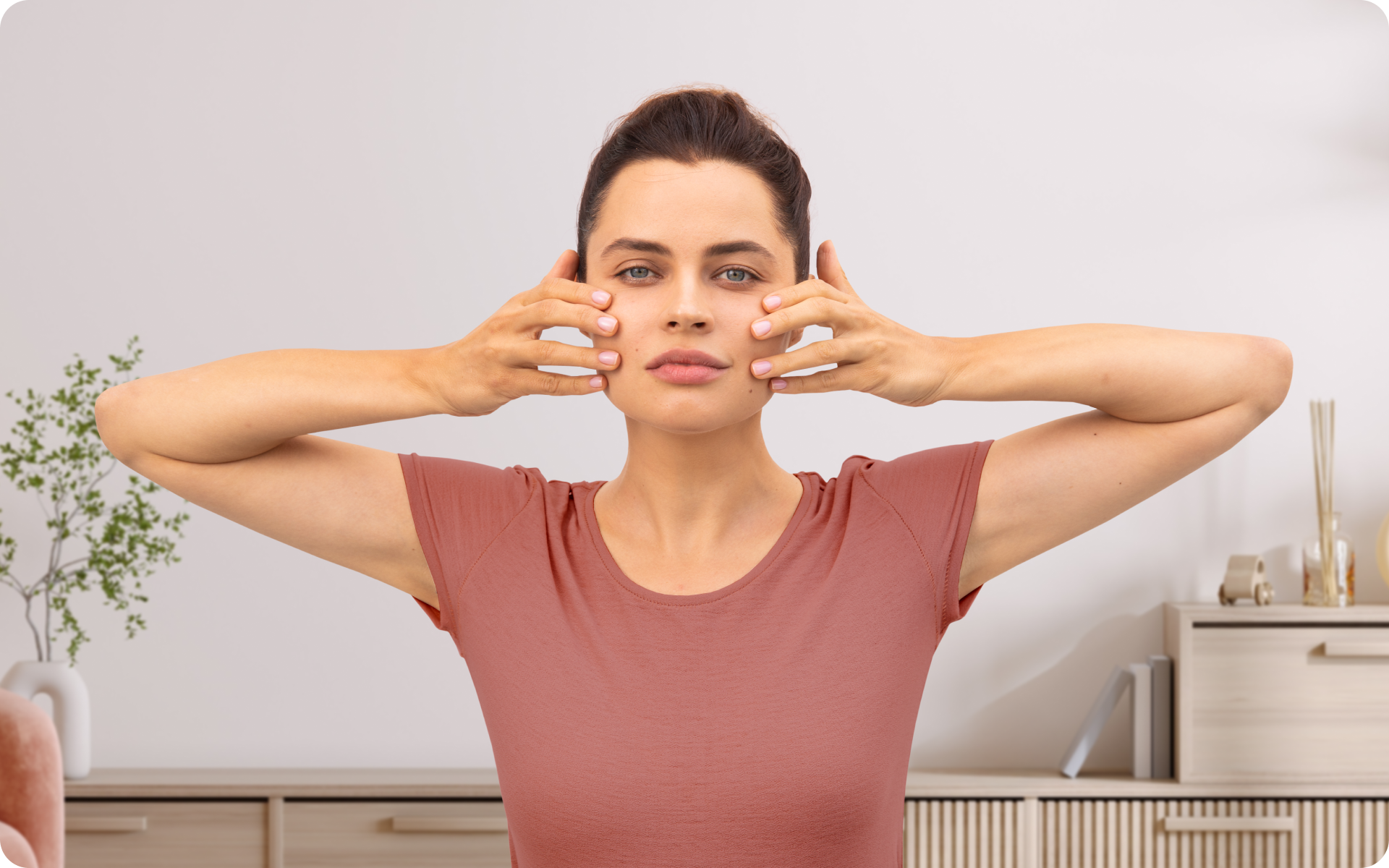Your face is the first thing people notice, which is why many of us pay attention to how it looks and feels. From doing extensive skin care routines to lining up beard and hairline perfectly, the face is a source of pride and joy to many.
Fortunately, or unfortunately – depending on how you look at it – the extra attention we pay to our faces means we’re more likely to notice even the smallest details/changes in this area.
Many people wonder ‘What causes face fat?’ and how this ties into their overall health and lifestyle. Whether it’s for confidence, comfort, or simply curiosity, understanding the causes behind facial fullness can help you embrace your features or take the first step toward making changes.
In this article, we’ll explore the most common factors that are associated with face fat, debunk myths, and share practical insights relating to losing face fat healthily and sustainably.
What Are the Causes of Face Fat?
Before you start researching how to slim your face, it’s best to first find the underlying cause of your now fuller face. Some reasons behind a fat face include:
1. Genetics
According to scientific research, genetics plays a huge role in how body fat is distributed and stored in your body (1, 2). This determines which parts of your body get fat and also tells some of the reasons why some ethnic groups are more prone to obesity and metabolic complications (2). If you’re concerned about your fuller face, take a look at your family – close and extended. If they have fuller faces, this may explain why your face is chubby.
2. Hormonal Changes
When it comes to the question ‘what causes face fat in women, especially older women?’ the answer could likely be hormonal changes, specifically due to menopause. In a narrative review published in late 2021, researchers mentioned that menopause is associated with significant changes in body composition and the accumulation of peri-abdominal or visceral fat (3).
In an older study from 2004, researchers also mentioned that facial fat (particularly in the cheeks and neck) may be strongly associated with visceral abdominal fat accumulation. (4).
Therefore, if hormonal changes at menopause cause an increase in abdominal and visceral fat together with general body composition changes, women’s hormones at this phase of their lives could lead to a fuller face.
Are you a man with a fuller face? Check out our article on face exercises for men to see how you can combat this issue.
3. Aging
Getting older comes with many changes and challenges. Scientific research has linked aging with reduced muscle mass and increased fat mass, both of which are factors that increase the prevalence of obesity (5, 6) and may also increase the likelihood of increased fat in the face.
When it comes to weight loss, progress is made by inches, not miles, so it’s much harder to track and a lot easier to give up. The BetterMe: Health Coaching app is your personal trainer, nutritionist, and support system all in one. Start using our app to stay on track and hold yourself accountable!
4. A Sedentary Lifestyle
Scientists define sedentary behavior as any waking behavior, such as sitting or leaning, that has an energy expenditure of 1.5 metabolic equivalent task (MET) or less (7).
Habits such as television viewing, playing video games, using a computer, sitting at school or work, and sitting while commuting are all examples of sedentary behavior, and when they take up the bulk of your days, they make up a sedentary lifestyle (7).
Such a way of living has been linked to weight gain, overweight, and obesity (7, 8). As we can’t determine where increased body fat from weight gain, overweight, and obesity will be stored, some of it can be stored in the face, thereby making your face fuller.
It’s also important to note that a sedentary lifestyle increases the risk of chronic inflammation. Chronic inflammation increases the risk of (7, 8):
- Metabolic disorders such as type 2 diabetes, hypertension, and dyslipidemia
- Cardiovascular diseases
- Some types of cancer
- Musculoskeletal disorders such as arthralgia and osteoporosis
- Mental health diseases and disorders, such as depression and cognitive impairment
- Early death
5. Bad Diet
In a study of young Japanese women, researchers found that the group of women who consumed a high-calorie diet had fuller and wider faces. They concluded that in addition to your body composition, your diet also plays a role in the shape and fullness of your face (9).
Remember that:
- A diet that’s higher in calories isn’t necessarily bad, as long as those calories are in line with your weight goals. You can use a reputable calorie counter app to find out how many calories you should be consuming in a day.
- Always choose nutrient-dense foods over energy-dense foods. Nutrient-dense foods offer more beneficial nutrients per calorie, while energy-dense foods offer fewer nutrients per calorie.
- While there are no specific foods that make your face fat, unhealthy foods, snacks, or drinks that are rich in sodium, added sugars, and overly processed do cause weight gain and, in some cases, water retention, which will lead to a fuller face.
6. Water Retention
Water retention is a condition where parts of your body, usually the face, legs, ankles, hands, and feet, swell up due to an excessive buildup of water in your body. This fluid buildup is caused by various dietary and health-related factors, two of which may be high-carbohydrate or high-sodium diets. However, research has not reached a full consensus on this (10, 11).
Read more: The Benefits of Not Drinking Soda or Why This Sugary Beverage Is Worth Quitting
What Causes Face Fat in Slim People?
A fuller face in slim people or those with a healthy weight could be due to:
- Water retention that makes your face swell up. Drinking water, dietary changes, and exercising can help flush out this excess fluid, but if you notice significant swelling in your face or other areas, it’s important to speak to a doctor about this.
- Genetics, where regardless of being slim, you naturally have a fuller/chubbier face. There is little that can be done about this.
- Hormonal changes – As demonstrated above, menopause can lead to weight gain regardless of a physically active lifestyle due to declining estrogen levels. While the abdomen is where most of this fat accumulates, you may find that your face is the first place to show fat accumulation.
Why Am I Skinny But My Face Is Chubby?
As mentioned in the previous section, this could be due to genetics, hormonal changes, or water retention, or even be a side effect of the aging process.
Does Cutting Sugar Reduce Face Fat?
Yes, reducing your sugar intake may help you reduce and lose face fat. Scientific studies have linked increased sugar intake to weight gain and obesity (12, 13).
As mentioned in the ‘causes of face fat’ section above, a bad diet can lead to weight gain, which will make your face fuller.
So you should ditch the sugar, eat a balanced, calorie-deficient diet, and increase your physical activity – this may help reduce your body fat in all areas, including the face.
Does Drinking Water Help Lose Face Fat?
Yes, it can. Weight gain is one of the causes of increased facial fat. Reducing your calorie intake helps with overall weight and fat loss in all areas, which includes the face.
Consuming more water throughout the day can help control your hunger, which helps you consume fewer calories, thereby helping with gradual fat and weight loss.
Drinking water in place of sugary drinks also helps reduce your sugar and empty calorie intake, which contributes to fat loss all over the body, including the face.
How Can I Slim Down My Face Naturally?
Some tips that can help you lose face fat include:
Increase Your Physical Activity
Increased fat in the body and water retention are the biggest causes of facial fat, and both issues may be overcome by increasing your amount of physical activity. Try engaging in at least 30 minutes of exercise a day, 5 days a week.
A combination of cardio and resistance training workouts will help flush out any excess water that may be making your face puffy and help with gradual and sustainable weight loss, thereby leading to a slimmer body and face.
BetterMe is your fast-track ticket to long-lasting weight loss! Tailor your fitness journey and maximize your results with just a couple of swipes!
Watch Your Diet
Don’t overeat, avoid high-sodium foods, and watch your carbohydrate intake, particularly refined carbs. The former contributes to increased stored fat in the body, while the latter two lead to water retention.
Gua sha is a facial massage technique that is believed to help with facial puffiness and water retention in the face. Learn more about this ancient Chinese technique here.
Can Facial Exercises Help with Face Slimming?
While research on the use of facial exercises for face slimming remains limited, many people still believe these workouts can help with face muscle conditioning, training, and strengthening, which may help give a slimmer appearance to the area.
All we can say is that spot reduction remains a myth, and it’s incredibly unlikely that these exercises alone will help with this issue. However, facial exercises aren’t in vain. Multiple studies have shown that these workouts may help rejuvenate aging skin, which can help reduce signs of aging and give you a more youthful appearance (14, 15, 16, 17).
Read more: High Protein Mediterranean Diet: Pillars, Best Protein Sources & More
When Does Face Fat Go Away?
As with any other fat on the body, facial fat will take anywhere from several weeks to a few months of a good and balanced calorie-deficient diet plus consistent exercise to noticeably reduce or fully go away. However, you should remember that there may also be a genetic component that’s not changeable.
It could be down to two reasons: Yes, they can. Muscle loss and hormonal changes may cause increased facial fat, but as you continue to age, you keep losing fat, which can cause chubby cheeks to reduce. Yes, it does. A running workout will lead to weight and fat loss in your face and other areas of your body over time when done consistently. Yes, facial fat can be genetic.Frequently Asked Questions
Why is face fat so difficult to lose?
Do chubby cheeks go away with age?
Does running reduce face fat?
Is face fat genetic?
The Bottom Line
The answer to ‘what causes face fat?’ is more complicated than you might think. Due to the multiple reasons behind facial fat, it’s best to first trace the cause so you can find the proper solution to your specific issue. However, the best way to prevent or even manage a fuller face is simply to increase your daily physical activity, watch your diet, and stay hydrated. Unless it’s genetic, these three factors can easily help effectively slim down your face.
DISCLAIMER:
This article is intended for general informational purposes only and does not serve to address individual circumstances. It is not a substitute for professional advice or help and should not be relied on for making any kind of decision-making. Any action taken as a direct or indirect result of the information in this article is entirely at your own risk and is your sole responsibility.
BetterMe, its content staff, and its medical advisors accept no responsibility for inaccuracies, errors, misstatements, inconsistencies, or omissions and specifically disclaim any liability, loss or risk, personal, professional or otherwise, which may be incurred as a consequence, directly or indirectly, of the use and/or application of any content.
You should always seek the advice of your physician or other qualified health provider with any questions you may have regarding a medical condition or your specific situation. Never disregard professional medical advice or delay seeking it because of BetterMe content. If you suspect or think you may have a medical emergency, call your doctor.
SOURCES:
- The genetics of fat distribution (2014, pubmed.ncbi.nlm.nih.gov)
- Genetics of Body Fat Distribution: Comparative Analyses in Populations with European, Asian and African Ancestries (2021, pmc.ncbi.nlm.nih.gov)
- Weight, Shape, and Body Composition Changes at Menopause (2021, pmc.ncbi.nlm.nih.gov)
- Facial fat and its relationship to abdominal fat: a marker for insulin resistance? (2004, sciencedirect.com)
- Muscle tissue changes with aging (2010, pmc.ncbi.nlm.nih.gov)
- Metabolic changes in aging humans: current evidence and therapeutic strategies (2022, pmc.ncbi.nlm.nih.gov)
- Sedentary Lifestyle: Overview of Updated Evidence of Potential Health Risks (2020, pmc.ncbi.nlm.nih.gov)
- Why we should sit less (2022, nhs.uk)
- Influence of the nutritional status on facial morphology in young Japanese women (2022, nature.com)
- Salt and water: not so simple (2017, pmc.ncbi.nlm.nih.gov)
- Sodium Intake and Hypertension (2019, pmc.ncbi.nlm.nih.gov)
- The Dose Makes the Poison: Sugar and Obesity in the United States – a Review (2019, pmc.ncbi.nlm.nih.gov)
- Added sugar intake is associated with weight gain and risk of developing obesity over 30 years: The CARDIA study (2024, sciencedirect.com)
- Association of Facial Exercise With the Appearance of Aging (2018, pmc.ncbi.nlm.nih.gov)
- Effect of a Facial Muscle Exercise Device on Facial Rejuvenation (2018, pmc.ncbi.nlm.nih.gov)
- Facial exercises for rejuvenation: A systematic review (2024, scielo.br)
- Effect of Intensive Face Yoga on Facial Muscles Tonus, Stiffness, and Elasticity in Middle-Aged Women: A Pre-Experimental Clinical Trial (2025, mdpi.com)















